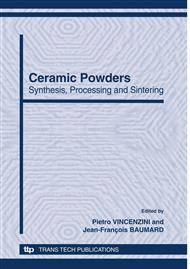[1]
D.E. Walton and C.J. Mumford: Trans IChemE Vol. 77 Part A (1999), pp.: 442-460.
Google Scholar
[2]
J. Subero, D. Pascual and M. Ghadiri: Trans IChemE Vol. 78 Part A (2000), pp.55-60.
Google Scholar
[3]
S. Tanaka, C. Chia-Pin, Z. Kato, K. Uematsu: J. Euro. Ceram. Soc. Vol. 27 (2007), pp.873-877.
Google Scholar
[4]
S. Antonyuk, J. Tomas, S. Heinrich and L. Mörl: Chemical Engineering Science Vol. 60 (2005), pp.4031-4044.
DOI: 10.1016/j.ces.2005.02.038
Google Scholar
[5]
A.D. Salman, G.K. Reynolds, H.S. Tan, I. Gabbott and M.J. Hounslow in: Granulation, edited by A.D. Salman, M.J. Hounslow and J.P.K. Seville, Volume 11 of Handbook of Powder Technology, Chapter 21, Elsevier (2007).
DOI: 10.1016/s0167-3785(07)80056-x
Google Scholar
[6]
M. Fries: Produktgestaltung keramischer Sprühgranulate für die uniaxiale Pressverdichtung zu großformatigen Bauteilen (Dissertation, Fraunhofer Verlag, Deutschland 2009).
Google Scholar
[7]
W.J. Walker, J.S. Reed and S.K. Verma: J. Am. Ceram. Soc. Vol 82-7 (1999), pp.1711-1719.
Google Scholar
[8]
G. Bertrand, C. Filiatre, H. Mahdjoub, A. Fossy and C. Coddet: J. Euro. Chem. Soc. Vol. 23 (2003), pp.263-271.
Google Scholar
[9]
G. Bertrand, P. Roye, C. Filiatre and C. Coddet: Chem. Eng. Sci. Vol. 60 (2005), pp.95-102.
Google Scholar
[10]
J. Tsubaki, H. Yamakawa, T. Mori and H. Mori: Optimization of Granules and Slurries for Press Forming, J. Ceram. Soc. Jpn. Vol. 110-10 (2002), pp.894-898.
DOI: 10.2109/jcersj.110.894
Google Scholar
[11]
A. Tsetsekou, C. Agrafiotis, I. Leon and A. Milias: J. Euro. Chem. Soc. Vol. 21 (2001), pp.493-506.
Google Scholar
[12]
T. Hotta, K. Nakahira, M. Naito, N. Shinohara, M. Okumiya and K. Uematsu: J. Euro. Ceram. Soc. Vol. 21 (2001), pp.603-610.
Google Scholar
[13]
A. Soottitantawat, J. Peigney, Y. Uekaji, H. Yoshii, T. Furuta, M. Ohgawara and P. Linko: Asis-Pac. J. Chem. Eng. Vol. 2 (2007), pp.41-46.
DOI: 10.1002/apj.55
Google Scholar
[14]
S. Höhn: Charakterisierungsmethoden für Granulate, Grünkörper und Werkstoffe im angesinterten Zustand, Dissertation (2010, in preparation) Fraunhofer IKTS.
Google Scholar
[15]
H. Takahashi, N. Shinohara, M. Okumiya, K. Uematsu, T. Junichiro, Y. Iwamoto and H. Kamiya, J. Am. Chem. Soc. Vol. 78-4 (1995), pp.903-908.
DOI: 10.1111/j.1151-2916.1995.tb08412.x
Google Scholar


